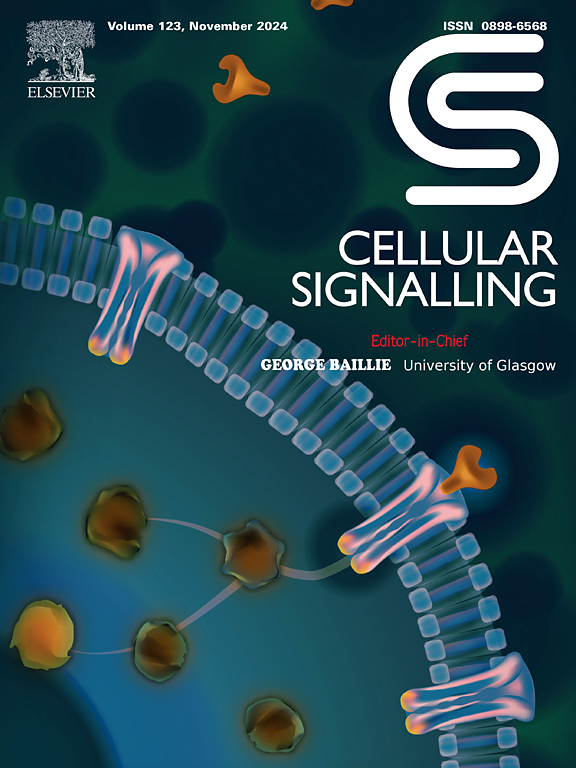TYROBP overexpression alters macrophage phenotype and enhances pancreatic cancer stemness through STAT3 and PKM2 signaling
IF 4.4
2区 生物学
Q2 CELL BIOLOGY
引用次数: 0
Abstract
Background
Pancreatic ductal adenocarcinoma (PDAC) is characterized by a complex tumor microenvironment (TME) that influences tumor progression and therapeutic responses. TYRO protein tyrosine kinase binding protein (TYROBP), a transmembrane polypeptide involved in immune cell signaling, has been implicated in PDAC and associated with M2 macrophage polarization.
Methods
We investigated the correlation between TYROBP expression and M2 macrophage infiltration in PDAC tissues using multiplex immunofluorescence staining. We also engineered TYROBP overexpression in SW1990 and Capan-1 pancreatic cancer cell lines to evaluate its impact on cell migration and macrophage polarization. Furthermore, we conducted co-culture experiments with SW1990 cells and THP-1 cells to explore the role of TYROBP in macrophage-mediated SW1990 cell proliferation and stemness. Nuclear translocation of STAT3 and PKM2 was assessed in TYROBP-overexpressing SW1990 cells, and the regulatory effects of STAT3 and PKM2 on CXCL8 expression were examined. Finally, molecular docking studies were performed to evaluate the binding of baicalein to STAT3, and in vivo studies assessed the inhibitory effects of baicalein on SW1990 cell proliferation.
Results
High TYROBP expression in PDAC tissues correlated with increased M2 macrophage infiltration, as indicated by elevated CD68 and CD206 levels. TYROBP overexpression promotes M2 macrophage polarization and glycolytic reprogramming via STAT3/PKM2, validated in vitro and in vivo. TYROBP overexpression also promoted the nuclear translocation of STAT3 and PKM2, enhancing glycolytic activity in SW1990 cells. STAT3 and PKM2 cooperated to regulate CXCL8 expression via direct binding to the CXCL8 promoter region. Molecular docking demonstrated baicalein's binding to STAT3, and in vivo studies showed that baicalein significantly inhibited SW1990 cell growth and modulated key signaling pathways.
Conclusions
Our study reveals that high TYROBP expression is associated with increased M2 macrophage infiltration in PDAC, promoting a pro-tumorigenic TME. TYROBP overexpression drives macrophage polarization towards the M2 phenotype, enhances glycolytic activity, and modulates key signaling pathways. Baicalein, targeting STAT3, shows potential as a therapeutic agent for PDAC by inhibiting cell proliferation and modulating the TME. These findings highlight TYROBP as a key regulator in PDAC progression and suggest potential therapeutic strategies targeting TYROBP and its associated pathways.
TYROBP过表达通过STAT3和PKM2信号通路改变巨噬细胞表型并增强胰腺癌的干性
胰腺导管腺癌(PDAC)的特点是复杂的肿瘤微环境(TME)影响肿瘤进展和治疗反应。TYRO蛋白酪氨酸激酶结合蛋白(TYROBP)是一种参与免疫细胞信号传导的跨膜多肽,与PDAC有关,并与M2巨噬细胞极化有关。方法采用多重免疫荧光染色法研究PDAC组织中TYROBP表达与M2巨噬细胞浸润的关系。我们还设计了TYROBP在SW1990和Capan-1胰腺癌细胞系中的过表达,以评估其对细胞迁移和巨噬细胞极化的影响。此外,我们将SW1990细胞与THP-1细胞共培养实验,探讨TYROBP在巨噬细胞介导的SW1990细胞增殖和干细胞形成中的作用。在tyrobp过表达的SW1990细胞中评估STAT3和PKM2的核易位,并检测STAT3和PKM2对CXCL8表达的调节作用。最后,通过分子对接研究评估黄芩素与STAT3的结合,并在体内研究评估黄芩素对SW1990细胞增殖的抑制作用。结果PDAC组织中TYROBP高表达与M2巨噬细胞浸润增加相关,CD68和CD206水平升高。TYROBP过表达通过STAT3/PKM2促进M2巨噬细胞极化和糖酵解重编程,这在体外和体内都得到了验证。TYROBP过表达还促进了STAT3和PKM2的核易位,增强了SW1990细胞的糖酵解活性。STAT3和PKM2通过直接结合CXCL8启动子区共同调控CXCL8的表达。分子对接证实黄芩素与STAT3结合,体内研究表明黄芩素显著抑制SW1990细胞生长并调节关键信号通路。结论TYROBP高表达与PDAC中M2巨噬细胞浸润增加有关,促进促瘤性TME。TYROBP过表达驱动巨噬细胞向M2表型极化,增强糖酵解活性,调节关键信号通路。黄芩素以STAT3为靶点,通过抑制细胞增殖和调节TME,显示出作为PDAC治疗药物的潜力。这些发现强调了TYROBP在PDAC进展中的关键调节作用,并提出了针对TYROBP及其相关途径的潜在治疗策略。
本文章由计算机程序翻译,如有差异,请以英文原文为准。
求助全文
约1分钟内获得全文
求助全文
来源期刊

Cellular signalling
生物-细胞生物学
CiteScore
8.40
自引率
0.00%
发文量
250
审稿时长
27 days
期刊介绍:
Cellular Signalling publishes original research describing fundamental and clinical findings on the mechanisms, actions and structural components of cellular signalling systems in vitro and in vivo.
Cellular Signalling aims at full length research papers defining signalling systems ranging from microorganisms to cells, tissues and higher organisms.
 求助内容:
求助内容: 应助结果提醒方式:
应助结果提醒方式:


